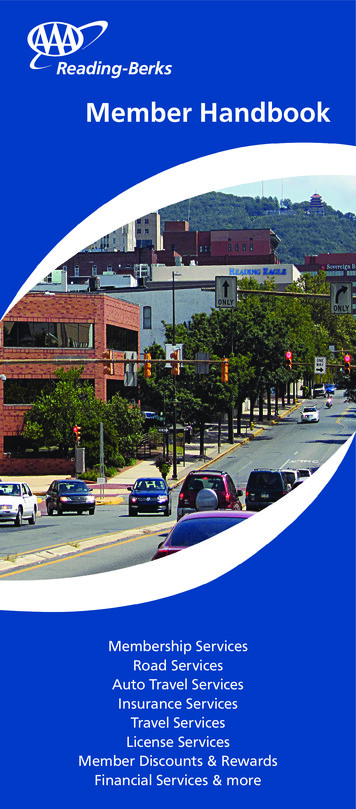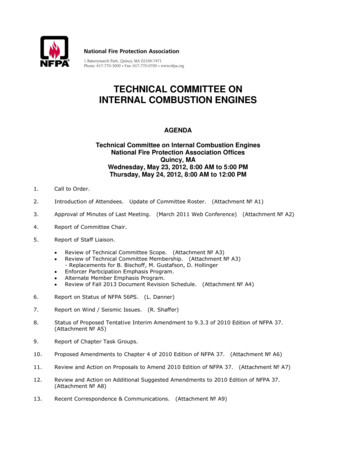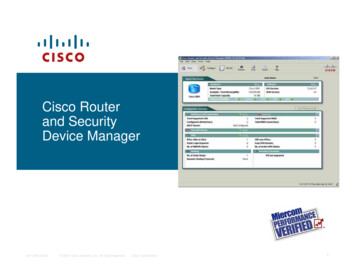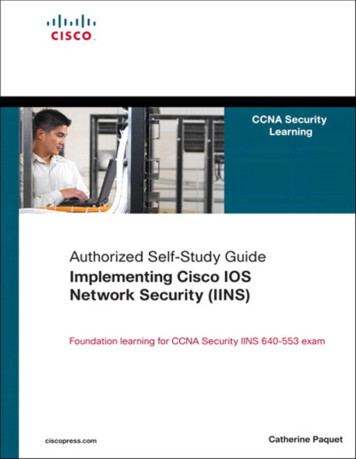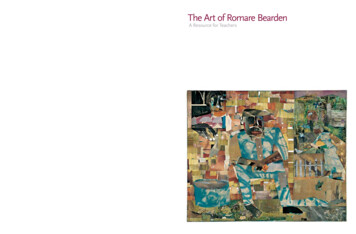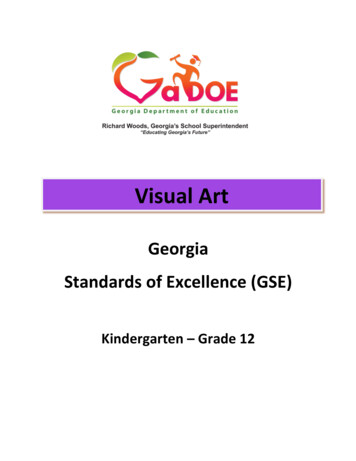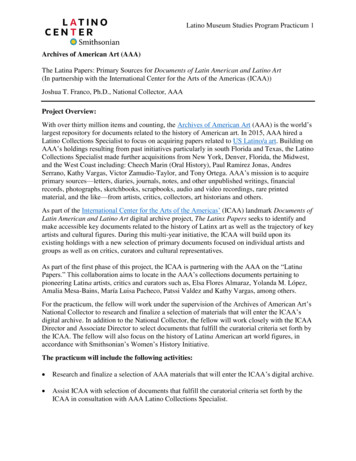
Transcription
Latino Museum Studies Program Practicum 1Archives of American Art (AAA)The Latina Papers: Primary Sources for Documents of Latin American and Latino Art(In partnership with the International Center for the Arts of the Americas (ICAA))Joshua T. Franco, Ph.D., National Collector, AAAProject Overview:With over thirty million items and counting, the Archives of American Art (AAA) is the world’slargest repository for documents related to the history of American art. In 2015, AAA hired aLatino Collections Specialist to focus on acquiring papers related to US Latino/a art. Building onAAA’s holdings resulting from past initiatives particularly in south Florida and Texas, the LatinoCollections Specialist made further acquisitions from New York, Denver, Florida, the Midwest,and the West Coast including: Cheech Marin (Oral History), Paul Ramirez Jonas, AndresSerrano, Kathy Vargas, Victor Zamudio-Taylor, and Tony Ortega. AAA’s mission is to acquireprimary sources—letters, diaries, journals, notes, and other unpublished writings, financialrecords, photographs, sketchbooks, scrapbooks, audio and video recordings, rare printedmaterial, and the like—from artists, critics, collectors, art historians and others.As part of the International Center for the Arts of the Americas’ (ICAA) landmark Documents ofLatin American and Latino Art digital archive project, The Latinx Papers seeks to identify andmake accessible key documents related to the history of Latinx art as well as the trajectory of keyartists and cultural figures. During this multi-year initiative, the ICAA will build upon itsexisting holdings with a new selection of primary documents focused on individual artists andgroups as well as on critics, curators and cultural representatives.As part of the first phase of this project, the ICAA is partnering with the AAA on the “LatinaPapers.” This collaboration aims to locate in the AAA’s collections documents pertaining topioneering Latina artists, critics and curators such as, Elsa Flores Almaraz, Yolanda M. López,Amalia Mesa-Bains, María Luisa Pacheco, Patssi Valdez and Kathy Vargas, among others.For the practicum, the fellow will work under the supervision of the Archives of American Art’sNational Collector to research and finalize a selection of materials that will enter the ICAA’sdigital archive. In addition to the National Collector, the fellow will work closely with the ICAADirector and Associate Director to select documents that fulfill the curatorial criteria set forth bythe ICAA. The fellow will also focus on the history of Latina American art world figures, inaccordance with Smithsonian’s Women’s History Initiative.The practicum will include the following activities: Research and finalize a selection of AAA materials that will enter the ICAA’s digital archive. Assist ICAA with selection of documents that fulfill the curatorial criteria set forth by theICAA in consultation with AAA Latino Collections Specialist.
Latino Museum Studies Program Practicum 1Practicum Goals: To encourage research skills in archival collections. To identify information-rich primarysource documents that succinctly document the contributions of Latinas to American art. To focus on the history of Latina American art world figures.Practicum may be best suited for students in the areas of:Art History, Library & Information Science, Latinx Studies, Women’s Studies, History,American Studies, Art, Ethnic Studies, English, and Comparative Literature, but all encouragedto apply.Spanish language skills preferred.
Latino Museum Studies Program Practicum 2Smithsonian Center for Folklife and Cultural Heritage (CFCH)Transcribing Latinidad: Activating Archival Access to Latinx-related CollectionsCecilia Peterson, Digital Projects Archivist, CFCHDave Walker, Audiovisual Archivist, CFCHProject Overview:The Ralph Rinzler Folklife Archives at the Smithsonian Center for Folklife and CulturalHeritage is home to some of the world’s most important ethnographic documentary materialsfrom the second half of the twentieth century. This includes documentation of the SmithsonianFolklife Festival (which began in 1967 as the Festival of American Folklife) as well as video oforiginal field research and special projects conducted across the country and around the world byCenter curators and staff. The Rinzler Archives is also home more than a dozen collections ofrecord labels acquired and curated by the Center’s non-profit record label Smithsonian FolkwaysRecords (SFR). The collections are strong in American, and more specifically Euro-American,African-American, Caribbean, and Native American musical, performance, and material culturetraditions.Based on our collections, we intend the Fellow’s activities to range from on-site archivalresearch, and active participation in feedback sessions with web, archival, and curatorial staff.Specifically, we would like the Fellow to focus on preparing a Smithsonian Transcription Centerproject, drawing from Latinx- and Mestizx-related narrative sessions from the 1980s Festival ofAmerican Folklife. The Smithsonian Transcription Center seeks to engage the public in makingSmithsonian collections more accessible. This crowdsourcing project was developed as acollaborative way to digitally enable and increase public engagement with Smithsonianmaterials, increase access and use of our digitized content, and create pathways of learning andnew knowledge between the public and Smithsonian staff.Responsibilities for this project include: Identify Latinx- and Mestizx-related narrative sessions in recently digitized 1980s open reeltape recorded at the Festival of American Folklife. Propose a theme or topic that groups a selection of the tapes in preparation for a futureSmithsonian Transcription Center project. Prepare project spreadsheets to be used to import recordings into SmithsonianTranscription Center. Produce one multimedia article in English and Spanish for Folklife Magazine featuringselected recordings and related photographs from Archives, contextualizing and promotingthe Transcription Center projects. Project final report and presentation.
Latino Museum Studies Program Practicum 2Practicum Goal: To contribute to web-based resources that will tell larger stories and provide context aroundLatinx-related content through an interface that will be available in English and Spanish. Strengthen their familiarity with archival collections care, practices, and procedures.Practicum may be best suited for students in the areas of:Library and Information Science, American Studies, Curatorial Studies, Latino/a/x Studies,Public History, and Digital Humanities, but all encouraged to apply.Bilingual skills (Spanish) required, background in library sciences preferred.
Latino Museum Studies Program Practicum 3Archives Center, National Museum of American History (NMAH)¡Escúchame!: Spanish-Language Broadcast History in the ArchivesDaniela Jiménez, Archivist, NMAHProject Overview:The Archives Center was created in the early 1980s to serve as a repository for archival collectionsfrom the National Museum of American History and to acquire additional collections in support ofthe museum's research, exhibitions, and collecting programs.With few exceptions, Archives Center collections are acquired by donation, often in conjunction withthe acquisition of related artifacts, and in collaboration with the Museum's curatorial staff.Documentation projects –including oral and video histories– actively create new research collections.The Museum's ability to acquire and care for artifacts and archival materials in all physical formats,and generate contemporary documentation, gives it a unique capacity to record the complexity andrichness of the American experience.In support of the “¡Escúchame!: the History of Spanish-language Broadcasting in the U.S.” collectinginitiative at NMAH, the Archives Center is processing archival material addenda collected bycurators, Dr. Kathleen Franz and Dr. Mireya Loza. The addenda include material recently acquiredfrom prominent Latinas in broadcasting. The fellow will carry out essential tasks that will enable thearchival material to be publicly accessible.Responsibilities for this project include: Process identified collection(s): organize and arrange for physical access, describe for intellectualaccess, and properly house archival materials according to established national standards and bestpractices.Describe archival collection (s) using the Archivist’s Toolkit system and the resulting finding aid(s) will be ingested into the central finding aid database repository, indexed and made availableon SOVA (Smithsonian Online Virtual Archives).Practicum Goal: To carry out essential tasks that will enable the archival material to be publicly accessible insupport of the “¡Escúchame!: the History of Spanish-language Broadcasting in the U.S.”initiative.Practicum may be best suited for students in the areas of:Library and Information Science, History, American Studies, Anthropology, Sociology, MediaStudies, Cultural Studies, but all encouraged to apply.Bilingual skills (Spanish) required, background in library sciences preferred.
Latino Museum Studies Program Practicum 4National Museum of American History (NMAH)Latino Political History InitiativeNancy Bercaw, Ph.D., Curator, Division of Political and Military History, NMAHProject Overview:The Division of Political and Military History works to document Latinos’ political impact onmainstream democratic practices. Building upon the strengths of the National Museum ofAmerican History’s Political History Collections, the Initiative focuses on innovative politicalorganizing strategies developed and employed by undocumented youth to affect national policy.Much like antislavery advocates, women’s suffragists, and Civil Rights workers, undocumentedAmericans have influenced government policy without the right to vote. Through interviews, oralhistories, and fieldwork, the Initiative seeks to listen, synthesize, and record how Latinos impactdemocratic practices.The Division of Political and Military History is looking for a bilingual fellow to assist with oralhistories and collaborate with the curatorial team to answer some of the following questions: How have Latinos impacted American political practice?How have Latinos challenged and transformed American understandings of rights anddemocracy throughout our history?How are these politics practiced today?How have at-risk undocumented Americans formed a powerful national coalition?How did such an unprecedented movement emerge?How have these movements built upon a cultural citizenship to push for human rights?How are these actions transforming American understanding of citizenship?The practicum will include the following activities: Analyzing oral histories collected by the team and identifying dominant themes Writing abstracts for each oral history Pairing oral histories with objects collected by the project and writing content that can beshared online Present final report and presentation to the teamPracticum Goals: Gain experience working with objects and oral histories Learn how to develop public history content for a national museum Help innovate ways to reach new audiences
Latino Museum Studies Program Practicum 4 Assist in framing a political history narrative that resonates with Latino audiencesPracticum may be best suited for students in the areas of:American Studies, Ethnic Studies, and Public Humanities, but all encouraged to apply.Fellow must be organized, self-motivated, creative, and collaborativeSpanish language skills preferred.
Latino Museum Studies Program Practicum 5National Museum of American History (NMAH)Latinx Music Collection in the upcoming Entertaining America exhibitionJohn Troutman, Ph.D., Curator of American Music, NMAHProject Overview:The National Museum of American History’s Division of Culture and the Arts is gearing up forthe opening of Entertaining America in 2021. This exhibition, slated to run for 20 years with newobjects and stories rotating in every year, explores how entertainment has served as a primaryplatform for national conversations on politics, society, and what it means to be American.The exhibition team is currently developing object information and digital content that willcoincide with the physical exhibition and reach vastly more audiences through digital platforms.Working with the curatorial team of Entertaining America, the fellow will contribute toexhibition development through producing media content such as blog posts and social mediaproposals, web label, image, research, and other content support.In addition, the fellow will assist with the division’s efforts in continuing to collect, document,exhibiting and develop online content for historical Latinx cultural objects, focusing on Latinas.The practicum will include the following activities: Production of online content related to Latinx musical and other entertainment-relatedcontent to complement the upcoming exhibition Entertaining America Support curatorial team with exhibition logistics such as research, photography, and mediacontent Website content contributor, producing blog posts on Latinx-related objects and developingweb labels for Latinx collections for online access Research supporting division efforts to collect, document, exhibiting and develop onlinecontent for historical Latinx cultural objects, focusing on Latinas. Project final report and presentationPracticum Goals: To provide an overview of the production of online object information and interpretivecontent at the National Museum of American History To support the continued development of Latinx music content in the Entertaining Americaexhibition opening 2021Practicum may be best suited for students in the areas of: Ethnomusicology, Music, Exhibition Design, History, American Studies, Anthropology,Latina/o/x Studies, but all encouraged to apply.
Latino Museum Studies Program Practicum 6National Museum of American History (NMAH)Latina Philanthropy Collecting InitiativeAmanda B. Moniz, Ph.D., David M. Rubenstein Curator of Philanthropy, NMAHProject Overview:The War and Latina/o Philanthropy Collecting Initiative is a focused effort, supported by theSmithsonian’s Latino Center, to build Latina/o-related holdings in the philanthropy collection atthe National Museum of American History. Launched in 2015, the Smithsonian’s PhilanthropyInitiative is a long-term project to collect, research, document, and display materials relating tothe history and impact of American giving, broadly defined--from gifts of time and expertise tosocial activism and funding. Through onsite and online exhibitions, digital resources, and publicprograms, the Initiative engages audiences in conversations about the role philanthropy hasplayed and continues to play in the formation and re-formation of our country.This project is the first component of the Philanthropy Initiative dedication to researching,collecting, and sharing the experiences of Latina/o gifts of time, talent, and treasure to aid others.Throughout American history, wars have catalyzed changes in philanthropy. Yet there is littlehistorical scholarship on Latina/o philanthropy in the context of wars, and the Museum’sholdings reflect this lacuna.The Smithsonian has launched the Because of Her Story, the American Women’s HistoryInitiative. It aims to create, disseminate, and amplify the historical record of theaccomplishments of American women. This practicum will focus on exploring Latinaphilanthropy during and in the aftermath of wars the United States joined formally. It would alsoconsider the impact of wars, such as the Mexican Revolution, Colombian civil war, and CentralAmerican conflicts, on Latina giving.Latinas have a strong and distinct tradition of philanthropy. Informal aid through family and kinnetworks is an especially important facet of Latina giving, although Latinas have also supportedone another through organizations, including mutualistas and churches, and the initiativeencompasses these diverse types of giving.The temporal focus is the period from the 1910s to present, and the geographic focus is onFlorida; Texas; and Washington, DC.In support of this project, the curator of philanthropy seeks a fellow to help make resources onLatina philanthropy more accessible to the public in general and to Latina/o/x communities andschoolchildren in particular.The practicum will include the following activities: Editing Latina oral histories conducted as part of the War and Latina/o PhilanthropyCollecting Initiative.
Latino Museum Studies Program Practicum 6 Researching one or more objects in the Museum’s collection supporting the War andLatina/o Philanthropy Collecting Initiative. Creating one or more Smithsonian Learning Lab modules on Latina philanthropists. Project final report and presentation.Practicum Goals: To carry out essential tasks that will enable Latina philanthropy objects and oral historiesto be publicly accessible in support of the Smithsonian’s Philanthropy Initiative; LatinoCenter; and strategic goal of reaching schoolchildren.Practicum may be best suited for students in the areas of:Women and Gender Studies, Latina/o/x Studies, History, American Studies, but all areencouraged to apply.Bilingual skills (Spanish/English) required and a background in history preferred.
Latino Museum Studies Program Practicum 7Smithsonian National Museum of American History (NMAH)¡Pleibol! In the Barrios and the Big Leagues / En Los Barrios y las Grandes LigasMargaret Salazar-Porzio, Ph.D., Curator of Latina/o History & Culture, Cultural and Community Life, NMAHRobin Morey, Curatorial Assistant, Cultural and Community Life, NMAHProject Overview:¡Pleibol! In the Barrios and the Big Leagues / En Los Barrios y las Grandes Ligas is a 1200 square foot,fully-bilingual exhibition opening at the NMAH in October 2020. The Smithsonian Institution TravelingExhibition Service (SITES) will simultaneously travel the exhibition to 15 U.S. cities through 2025.¡Pleibol! demonstrates how, over the 20th century, baseball has provided a field for Latinas/os to push andeventually breakdown cultural, social, and economic barriers in the United States. This collaborative researchand exhibition project presents previously untold stories about how Latina/o ball players in U.S. cities andrural areas in the 20th century have brought about new understandings of community, race, ethnicity, gender,American national identity, inter-group cooperation, civil rights, and immigration, while also transformingAmerica's pastime.As part of this exhibition project, and in order to increase accessibility and outreach, NMAH is collaboratingwith the Smithsonian Digitization Program Office (DPO) and the Smithsonian Latino Center (SLC) in a 3Ddigitization project featuring 16-18 selected objects that highlight Latino baseball history. The digitized objectswill make up a “virtual gallery” which will be featured on the ¡Pleibol! website, the SLC web and mobile app,and will be made available to SITES venues hosting the exhibition. 3D scanning will also provideopportunities for other uses such as 3D printing and AR/VR applications. The fellow will primarily beassisting in this aspect of the exhibition.The practicum will include the following activities: Working with National Museum of American History conservation’s efforts to survey, treat and mountobjects; working with NMAH staff and the DPO team to find and prepare a space for the imaging to takeplace; and coordinating object transfers between collections storage and imaging location (if the DPOscanning is not complete before the time of the practicum). Assisting in curating “virtual tours” of digitized objects; including conducting background research,writing object labels and supporting script, choosing accompanying images, maps, and/or figures, anddeveloping the flow of the tour. Considering potential educational applications for DPO data including digital 3D models, 3D printing, andAR/VR capabilities, in the context of the NMAH and traveling exhibitions and in collaboration with theSLC as part of their forthcoming app/Latino Digital Gallery. Communicating with local DC-based partners at the Congressional Hispanic Caucus and DCPS toprototype and beta-test virtual tours. Assisting the Smithsonian Latino Center Mobile Web and Mobile App team and the National Museum ofAmerican History new media team to integrate virtual tours into web applications. Supporting exhibition development when necessary.
Latino Museum Studies Program Practicum 7Practicum Goals: Developing skills to identify and analyze visual culture materials to tell stories that have broadand deep significance to American history and culture. Understanding the scholarly literature on the history of Latina/o baseball. Placing the history of Latina/o baseball in broader, national and international, contexts. Cultivating critical thinking skills about visual and material culture related to this history. Working with collections on object documentation to develop new research resources related tothe history Latinas/os and baseball. Learning curatorial acquisitions and processing best practices, and how the Smithsonian has acquiredmaterial culture related to the history of Latina/o baseball. Appreciating the work of public historians in a national museum.Practicum may be best suited for students in the areas of:Digital Humanities, Latina/o/x Studies, Physical Culture and Sports Studies, American Studies,Anthropology, Sociology, Labor Studies, but all encouraged to apply.
Latino Museum Studies Program Practicum 8National Museum of American History (NMAH)Latinx Health, History, and SexualityKatherine Ott, Ph.D., Curator, NMAHProject Overview:Supporting the division of History of Medicine and Science at the National Museum ofAmerican History, this project builds upon the division's on-going collecting and documentationrelated to the history of health, the body, and sexuality in Latinx communities. The Smithsonianhas launched the Because of Her Story, the American Women’s History Initiative. It aims tocreate, disseminate, and amplify the historical record of the accomplishments of Americanwomen. This practicum will have a particular focus on the dynamics of sexual orientation/genderidentity (SOGI) among women.The Division manages the largest and most significant collection of health-related artifacts in theWestern Hemisphere. The Collections in medical science seek to capture the historicalexperiences of researchers, physicians, communities, patients, and their families. Because ourmaterials related to sexuality, health, and Latinas is rudimentary, this practicum is designed tocreate both a base and rationale for collecting.The practicum will include the following activities: Research on one or more of the following related topics:o the queer identities of Latina's starting in the mid-1800s;o the intersectionality of disability and SOGI (including diagnosis, treatment,physical impairment, madness, neuro-diversity, and “invisible” disabilities);o HIV and AIDS and Latinas. Identify and evaluate resources at NMAH and elsewhere including:o objectso suggested primary and secondary materialso archives and other existing collectionso key historical people and eventso media, and similar Create annotated collecting guide that includes collecting sources and bibliographic referenceswhere appropriate. Project final report and presentationPracticum Goals: Enhance the museum's standing collections and guide future collecting related to sexuality,health, and Latinas.
Latino Museum Studies Program Practicum 8 Provide understanding of the basics of museum collecting, object-based research, andinterpretation.Practicum may be best suited for students in the areas of:Women and Gender Studies, Latina/o/x Studies, History, Creative Arts, American Studies,Anthropology, Medicine, Psychology, Sociology, but all are encouraged to apply.
Latino Museum Studies Program Practicum 9Smithsonian American Art Museum (SAAM)Researching Contextual History of Chicanx and Latinx GraphicsE. Carmen Ramos, Ph.D., Deputy Chief Curator & Curator of Latinx Art, SAAMProject Overview:SAAM holds the largest collection of Latinx art of any nationally specific museum in the UnitedStates. Begun in the late 1970s, our collection of nearly 1000 works of art across media featuresimportant milestones in the field and boasts strengths in Chicanx graphic arts, Puerto Ricancolonial paintings and sculpture, and works by artists who came of age during and after the civilrights era of the 1960s and 1970s. At SAAM, we challenge the historic exclusion of Latinx artand artists by preserving, presenting and interpreting Latinx art as a fundamental part of U.S. artand culture.In 1995, scholar Tomás Ybarra-Frausto donated 60 Chicanx posters to SAAM making Chicanographics an important strength of our collection. SAAM has dramatically expanded thiscollection with new acquisitions that include iconic works from the 1960s and 1970s, to worksproduced by a new generation of Chicanx and Latinx artists. Selections from this expandedcollection will be featured in the upcoming exhibition ¡Printing the Revolution! ChicanoGraphics from the Civil Rights Era to the Present opening in September 2020.The LMSP fellow will conduct historical and art historical research into specific Chicanx andrelated Latinx posters/graphics in SAAM’s collection, with a focus on works that may befeatured in future permanent collection displays at SAAM. Chicanx/Latinx graphic productionoften invokes specific local and regional references that may not be as evident now due to thepassage of time. Research will focus on illuminating the particular visual and textual referencesmade in graphic works that invoke local, state and federal issues, as well as regional cultures andhistory. This project will emphasize the contribution of Chicanx and Latina women of colorartists and the researcher will support the equitable representation of these artists in a broadergraphics history.The practicum will include the following activities: Research contextual history of specific Chicanx and Latinx posters and graphics in SAAM’scollection; this will entail academic research and may require engaging with artists and otherrelated cultural producers. Produce succinct research report for each assigned object that describes historical and artisticreferences, and lists relevant bibliographic sources. Final report and presentation.
Latino Museum Studies Program Practicum 9Practicum Goal: To conduct research into SAAM’s Chicanx and Latinx graphic collection that will enableSAAM curators to plan for their use in future permanent collection displays. At the end of the practicum, research will be placed in the curatorial file of each artist andwill assist future researchers of these works.Practicum may be best suited to students in the areas of:Art History, Chicana/o/x Studies, Latina/o/x Studies, History, American Studies and VisualCulture Studies; other fields with relevant experience to the topic are encouraged to apply.Bilingual skills required.
Latino Museum Studies Program Practicum 10Smithsonian Libraries (SIL)Evaluating the Smithsonian Libraries’ Latino Collections and ServicesKristen Bullard, Librarian, SILProject Overview:The collections and staff of the Smithsonian Libraries play a key role in helping theSmithsonian’s research and curatorial staff make sense of the museums’ almost innumerable,often unique, objects and their cultural and historical contexts. The network of 21 specializedresearch libraries that make up the Smithsonian Libraries provide the Institution’s museums andresearch centers with resources and services that are as diverse and deep as the collections,exhibits, and scholarship they support. They truly span the range of scientific and culturalpursuits of humanity from aerospace, anthropology, and art history to business history andbotany, cultural history, design, philately, zoology, and much, much more.While sharing the values, methods, and efficiencies of a unified network, each library in thesystem supports the work of its own community of interest comprising specialized researchersand museum curators, as well as visiting scholars, educators, students, and others pursuing oradvancing knowledge in their fields. Individually each of these libraries is among the world’sgreatest repositories of knowledge for the specialized fields they support.Via this practicum, the Libraries is seeking to better understand the research and scholarshipneeds of the Smithsonian Latino Center (SLC), its upcoming Molina Family Latino Gallery(MFLG), and online presence. The SLC, ensures “that the contributions of the Latino communityin the arts, history, national culture and scientific achievement are explored, presented,celebrated and preserved. [They] support research, exhibitions, public and educational programs,web-based content and virtual platforms, collections and archives, and publications. [They] alsomanage leadership and professional development programs for Latino youth, emerging scholarsand museum professionals.”The SLC is one of many units of the Smithsonian which are not directly served by the traditionalmodel of the existing 21 library branches. By learning from SLC staff about their needs andevaluating the Libraries collections and services based on these needs, the practicum student(s)will make recommendations to SLC and SIL for future collections and services collaborations.The practicum will include the following activities: Based on best practices and environmental scans:o Develop a method (user interviews, focus groups, etc.) to learn about the currentresearch and strategic initiatives of specialized units at the Smithsonian.o Develop a method for conducting a collections analysis of the Smithsonian Librariesmateri
Smithsonian Transcription Center project. Prepare project spreadsheets to be used to import recordings into Smithsonian Transcription Center. Produce one multimedia article in English and Spanish for Folklife Magazine featuring selected recordings and related

